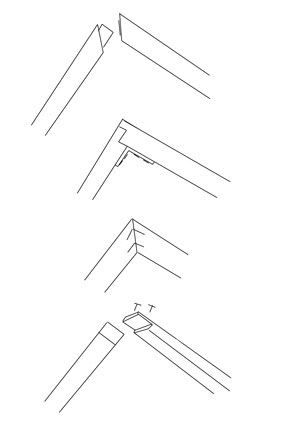Making your own canvas is always preferable to buying ready made. MOST ready made canvases are bad quality wood, canvas, and preparation, I think. Ok, if you have loads of dosh you can get ready made, as in you go to the shop and say I want YOU to make me a canvas in x size with x cloth and x preparation. But most of us aren't that fortunate.
So, to start. It all depends on how much money you want to spend. Basic pine should be fine as long as the wood isn't green, make sure the wood doesn't smell "fresh". If it is fresh, it will probably bow really easily over time and you'll end up with a warped canvas (this is often a problem with ready made ones). When you buy the wood, make sure that the length you choose is not bowed already too. Or as least bowed as possible.
The best way to make a canvas, depending on size, is to create a lock and key type joint at the edges, that makes it a lot more stable. But unless you have access to the proper machinery, this is hard to do. You can make a simple joint with just an electric saw.
Here are some ideas:

The first one is how most commercial canvases are made, there is a "key" of sorts" and a "lock" where the key goes. Usually these are glued together and that is enough.
The other 3 are variations on ways I have made canvases and seen canvases made.
The second image is quite sturdy, you have two cut out bits on the ends that lock together and you can glue and screw those together, and then to add sturdiness you can add on the inside an L shaped metal plate that you screw into the wood, making your canvases just that bit straighter at the corners.
The 3rd one is how frames are made, the ends are cut at a 45º angle and then butted together with l shaped metal pieces (hammered into it). Glue is also advisable here.
The 4th option is simple, another version of the cut out ends but where the wood is quite thin depth-wise but wider viewed from the front.
In all these cases, I recommend taking the time to cut out a little channel across the front inner edge of the wooden frame, to prevent the wood marking the canvas when you paint over the edge that touches (or if you do this doesn't) the canvas.
After this is part is done, You need cloth. I just go to a regular fabric store and buy the fabric of my choice. Usually in Portugal fabric stores sell all kinds of good materials for canvas. Just ask around. You can have cotton based cloth, jute, linen (expensive but oh so silky lol), among others. Plain cotton is ok to start. Your canvas really is anything you make it. You can paint on alomst anything you like with interesting results. I have a friend who paints on the material they use to cover trucks, you know? It's amazing what you can do with imagination. Always buy the cloth a good 10 cm over each edge of the wooden frame, just to make sure you don't run out. Also be careful for fabric salesmen who don't cut in very straight lines. Tough fabrics should be washed to get rid of starch, and also ironed if you want a perfect finish.
You don't need an expensive stretching tool to stretch your canvas. The best thing is to get someone to help you out. When you stretch the fabric over the frame, either you can use a staple gun to nail down the canvas, or upholstery nails. Staples are easier and faster. Start from the middle of one side of the frame, then do the opposite side. Depending on the fabric used (and this is down to experimenting), you can then either do the middle of the other two sides (always stretch the canvas as hard as you can), or continue doing the same side, then the opposite, till you've almost reached the edges. When it's all done except the edges, fold one edge over the other as neatly as possible (you don't want big lumps sticking up), stretch the fabric, and then staple them as well.
After this is done, you can prepare the canvas. There are all sorts of complicated preparation techniques. I'm lazy so I either use plastic indoor wall paint (good to stop absorption), two coats, or I mix 1/3 PVA glue with 2/3 primer paint and slap two coats of that on too. It depends how much paint you want (or don't want) the canvas to absorb. Sometimes watering down the priming mix is a good idea if you want a smoother finish. This preparation type is good for most types of paint I find.
So, I think that's it. Personally I tire of making the frame so I opt for spending good money on a good frame and do the rest of it myself.
Happy painting!